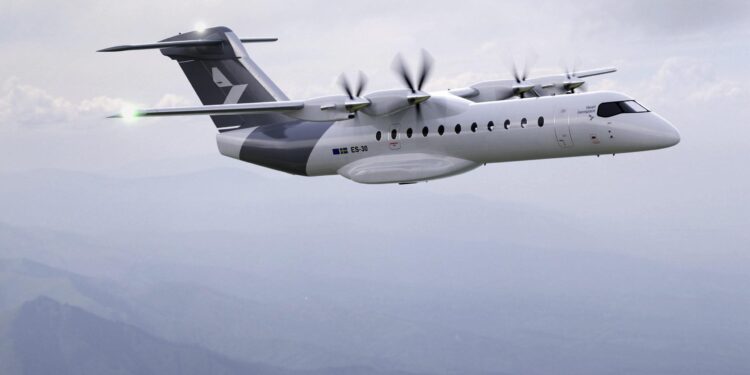Swedish aircraft manufacturer Heart Aerospace is set to advance the development of its all-electric ES-30 airplane through a new collaboration with the Ă…land Islands, a self-governing region of Finland. The partnership aims to explore the feasibility of integrating the ES-30 into the archipelago’s regional air transport network, marking a significant step toward sustainable aviation in Northern Europe. This initiative highlights growing industry momentum behind electric aircraft as a means to reduce carbon emissions and enhance connectivity in remote areas.
Heart Aerospace Partners with Ă…land Islands to Test Electric ES30 Aircraft
In a significant move towards sustainable aviation, Heart Aerospace has entered a collaboration with the Ă…land Islands to test its cutting-edge electric regional aircraft, the ES-30. This partnership aims to evaluate the operational capabilities and environmental benefits of the ES-30 within the unique geographic and climatic conditions of the Ă…land archipelago. The test flights will focus on demonstrating the aircraft’s efficiency, range, and noise reduction, which are critical factors for improving regional connectivity while minimizing ecological impact.
The program highlights several key advantages of the ES-30 electric aircraft:
- Zero-emission flights contributing to climate goals
- Reduced operating costs through lower fuel and maintenance expenses
- Improved passenger experience with quieter cabin environments
- Flexible route planning suitable for short regional hauls
This initiative positions the Ă…land Islands as a pioneering hub for electrified air transport, reflecting broader trends in the aviation industry’s shift towards greener technologies.
| Specification | ES-30 | Conventional Regional Aircraft |
|---|---|---|
| Seating Capacity | 30 | 30-40 |
| Maximum Range | 400 km (250 mi) | 750 km (466 mi) |
| Emissions | Zero | High COâ‚‚ |
| Noise Level | Low | High |
Assessing Environmental Impact and Operational Benefits of Electric Aviation in Nordic Regions
Heart Aerospace’s collaboration with the Ă…land Islands marks a pivotal moment in the transition toward sustainable air travel in the Nordic region. The introduction of the ES-30 electric aircraft is set to significantly reduce carbon emissions, aligning with the Nordic countries’ ambitious climate goals. Early assessments indicate that the ES-30’s electric propulsion system can cut CO2 emissions by up to 80% compared to conventional fossil-fuel-powered regional aircraft. Additionally, the aircraft’s quieter operation is expected to alleviate noise pollution in sensitive ecological zones, benefiting both local wildlife and residents.
Operational advantages extend beyond environmental gains, with Heart Aerospace highlighting several key benefits for regional airlines and airports:
- Lower Operating Costs: Electric engines reduce fuel and maintenance expenses.
- Increased Flight Efficiency: Enhanced aerodynamics and lightweight materials improve range and payload capacity.
- Improved Reliability: Electric systems minimize mechanical failures and downtime.
| Factor | ES-30 Electric Aircraft | Traditional Regional Aircraft |
|---|---|---|
| CO2 Emissions | ~80% less | Baseline |
| Noise Levels | Reduced by 50% | Standard |
| Maintenance Costs | 30% lower | Higher |
| Range | Up to 160 miles | Varies 150-300 miles |
Recommendations for Integrating ES30 Electric Planes into Island Connectivity and Sustainable Travel Plans
To effectively incorporate the ES-30 electric aircraft into island transportation networks like the Ă…land Islands, stakeholders should prioritize the development of dedicated charging infrastructure at regional airports. This includes establishing swift and reliable electric charging stations compatible with the aircraft’s battery system, while coordinating flight schedules to optimize turnaround times and minimize downtime. Additionally, aligning with local energy providers to source renewable electricity can fully capitalize on the ES-30’s zero-emission potential, reinforcing both environmental and economic sustainability goals.
Emphasizing community engagement will be key to maximizing adoption and ensuring seamless integration into existing travel plans. Authorities and operators should promote awareness campaigns highlighting the environmental benefits and operational efficiency of electric planes. Incorporating the ES-30 into multimodal transport plans-linking air travel with ferries, buses, and e-bike rentals-will expand accessibility and convenience for travelers. The following checklist outlines critical focus areas for successful deployment:
- Infrastructure readiness: charging stations, maintenance hubs
- Energy sourcing: commitment to renewable electricity
- Scheduling: synchronization with ground and sea transport
- Community outreach: educational programs and stakeholder forums
- Policy alignment: supportive regulations and subsidies
| Aspect | Recommendation | Benefit |
|---|---|---|
| Charging Infrastructure | Install fast-charging units at main airports | Reduced turnaround and operational costs |
| Renewable Energy | Partner with local solar and wind energy providers | Lower carbon footprint and energy expenses |
| Multimodal Integration | Coordinate schedules with ferries and buses | Improved passenger convenience and connectivity |
In Summary
As Heart Aerospace moves forward with its plans to explore the deployment of the electric ES-30 aircraft in the Ă…land Islands, the initiative marks a significant step towards greener regional air travel. The collaboration underscores the growing interest in sustainable aviation solutions and highlights the potential for electric aircraft to transform short-haul routes. Industry observers will be watching closely as this project progresses, potentially setting a precedent for similar efforts in other environmentally conscious regions.
















